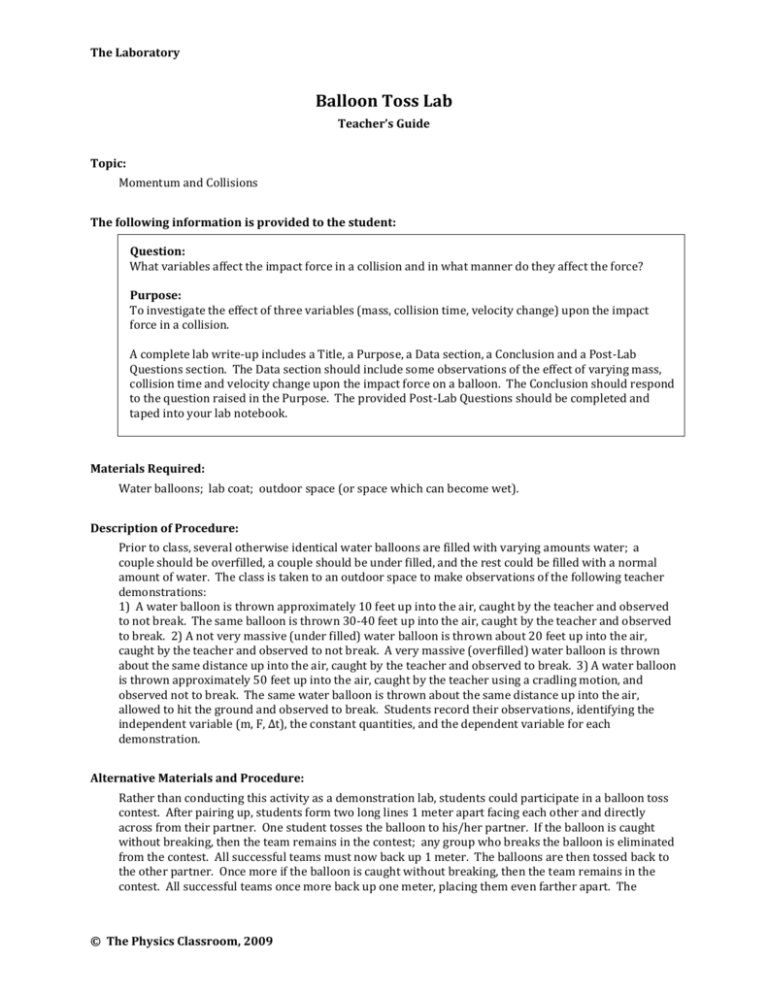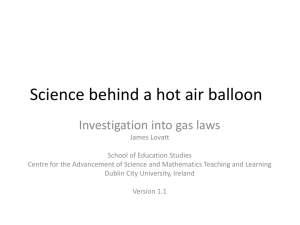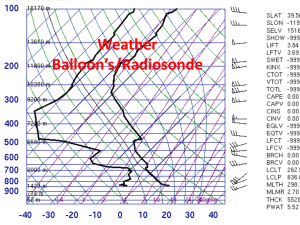MS Word - The Physics Classroom
advertisement

The Laboratory Balloon Toss Lab Teacher’s Guide Topic: Momentum and Collisions The following information is provided to the student: Question: What variables affect the impact force in a collision and in what manner do they affect the force? Purpose: To investigate the effect of three variables (mass, collision time, velocity change) upon the impact force in a collision. A complete lab write-up includes a Title, a Purpose, a Data section, a Conclusion and a Post-Lab Questions section. The Data section should include some observations of the effect of varying mass, collision time and velocity change upon the impact force on a balloon. The Conclusion should respond to the question raised in the Purpose. The provided Post-Lab Questions should be completed and taped into your lab notebook. Materials Required: Water balloons; lab coat; outdoor space (or space which can become wet). Description of Procedure: Prior to class, several otherwise identical water balloons are filled with varying amounts water; a couple should be overfilled, a couple should be under filled, and the rest could be filled with a normal amount of water. The class is taken to an outdoor space to make observations of the following teacher demonstrations: 1) A water balloon is thrown approximately 10 feet up into the air, caught by the teacher and observed to not break. The same balloon is thrown 30-40 feet up into the air, caught by the teacher and observed to break. 2) A not very massive (under filled) water balloon is thrown about 20 feet up into the air, caught by the teacher and observed to not break. A very massive (overfilled) water balloon is thrown about the same distance up into the air, caught by the teacher and observed to break. 3) A water balloon is thrown approximately 50 feet up into the air, caught by the teacher using a cradling motion, and observed not to break. The same water balloon is thrown about the same distance up into the air, allowed to hit the ground and observed to break. Students record their observations, identifying the independent variable (m, F, ∆t), the constant quantities, and the dependent variable for each demonstration. Alternative Materials and Procedure: Rather than conducting this activity as a demonstration lab, students could participate in a balloon toss contest. After pairing up, students form two long lines 1 meter apart facing each other and directly across from their partner. One student tosses the balloon to his/her partner. If the balloon is caught without breaking, then the team remains in the contest; any group who breaks the balloon is eliminated from the contest. All successful teams must now back up 1 meter. The balloons are then tossed back to the other partner. Once more if the balloon is caught without breaking, then the team remains in the contest. All successful teams once more back up one meter, placing them even farther apart. The © The Physics Classroom, 2009 The Laboratory process is continued until the winning team is identified. Once the class returns to the classroom, the variables which students tried to control and the manner in which they tried to control them is discussed. Safety Concern: There is always a higher than usual level of risk associated with working in a science lab. Teachers should be aware of this and take the necessary precautions to insure that the working environment is as safe as possible. Students should be warned that wet surfaces can be slippery and that they should exercise caution to avoid slipping. Student horseplay and off-task behaviors should not be tolerated. Suggestions, Precautions, Notes: 1. 2. 3. Remind students of the need to exercise caution when walking on wet surfaces. The inexpensive water balloons ($1 for a bag of 100) work great for this activity. This demonstration takes a little practice to become accustomed to the heights to which the balloons must be thrown in order to break or not break. The wetter you get in this demonstration, the more that students will remember it. Have fun. 4. Auxiliary Materials: The following page is provided to the student for completion and inclusion in the Post-Lab Questions section of their lab notebook. Post-Lab Questions: Assume that we were able to collect the following table of data for a balloon toss lab. The table represents numerical values for force, time, mass, velocity change, impulse, and momentum change for various catches of a balloon. Use the table to answer the following questions. a. b. c. d. e. f. Mass (kg) Velocity (m/s) 0.50 -4.0 Momentum (kg m/s) -2.0 0.10 -8.0 ∆Time (s) 0.100 -0.40 0.50 0.50 Force (N) 0.010 0.50 0.20 Impulse (N s) 0.010 -80 -400 -8.0 1.0 0.010 1. Use the impulse-momentum change theorem (and the definitions of impulse and momentum change) to fill in the above table. 2. The force required to stop a balloon is dependent upon the mass, velocity change, and collision time. Use the data in the table above to express your understanding of these relationships. What effect does a ten-fold increase in ∆time have upon the subsequent force which is required to change an object's momentum (assuming other quantities are constant)? a. Identify at least one set of two rows which illustrate this cause-effect relationship. © The Physics Classroom, 2009 The Laboratory b. What effect does a five-fold increase in mass have upon the subsequent force which is required to change an object's momentum (assuming other quantities are constant)? Identify at least one set of two rows which illustrate this cause-effect relationship. c. What effect does a two-fold increase in velocity change have upon the subsequent force which is required to change an object's momentum (assuming other quantities are constant)? Identify at least one set of two rows which illustrate this cause-effect relationship. Scoring Rubric: M2. Balloon Toss Lab Included, labeled and organized all parts of the lab report. Data section includes a table of observations made for the collision of several water balloons. Observations are well documented using notes, diagrams, words, etc. Conclusion responds to the question posed in the Purpose. The effect (direct or inverse) of the three variables upon force is clearly and accurately stated. Post-Lab Questions are answered and the provided page is taped in. Answers are correct. Score _____/_____ Connections to The Physics Classroom Tutorial: The following readings are a suitable accompaniment to this lab: http://www.physicsclassroom.com/Class/momentum/u4l1b.cfm http://www.physicsclassroom.com/Class/momentum/u4l1c.cfm Connections to Minds on Physics Internet Modules: Sublevels 2 and 3 of the Momentum and Collisions module are a suitable accompaniment to this lab: http://www.physicsclassroom.com/mop/module.cfm © The Physics Classroom, 2009








